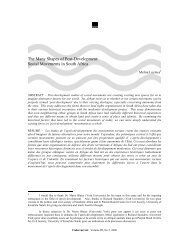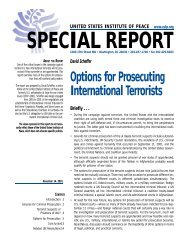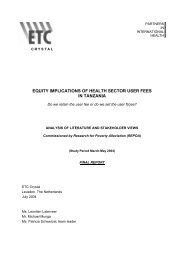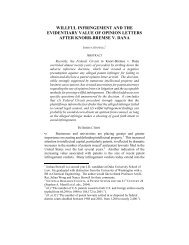Africa and the Geopolitics of the Indian Ocean
Africa and the Geopolitics of the Indian Ocean
Africa and the Geopolitics of the Indian Ocean
Create successful ePaper yourself
Turn your PDF publications into a flip-book with our unique Google optimized e-Paper software.
AfRICA ANd thE gEOPOLItICS Of thE INdIAN OCEAN<br />
development. India hopes to be able to go some way to challenging China for <strong>the</strong> best<br />
contracts <strong>and</strong> deals in <strong>Africa</strong>, while <strong>the</strong> <strong>Indian</strong> navy is active along <strong>the</strong> East <strong>Africa</strong>n coast,<br />
an area <strong>of</strong> continued maritime insecurity. 89<br />
For India, <strong>the</strong> very visible presence <strong>of</strong> extra-regional navies shows that o<strong>the</strong>r states are<br />
interested in <strong>the</strong> <strong>Indian</strong> <strong>Ocean</strong> region. In IOR countries <strong>and</strong> isl<strong>and</strong> states, major powers<br />
have stationed a variety <strong>of</strong> maritime ‘assets’, ranging from carrier battle groups, to forward<br />
bases, to maritime patrol aircraft <strong>and</strong> UAVs. India continues to observe China’s toe-holds<br />
in <strong>the</strong> IOR in order to gauge its intentions. 90 India <strong>and</strong> Mauritius seem to have resumed<br />
discussions over a proposal to h<strong>and</strong> over <strong>the</strong> twin isl<strong>and</strong>s <strong>of</strong> Agalega to India ei<strong>the</strong>r on<br />
long-lease or through perpetual ceding <strong>of</strong> control. The l<strong>and</strong> could be used for agriculture<br />
<strong>and</strong> o<strong>the</strong>r strategic purposes by India. 91<br />
India <strong>the</strong>refore enacts its maritime strategy by ensuring that perceived legitimate<br />
threats are not realised. The network <strong>of</strong> co-operative partnerships, which it continues to<br />
build with select IOR nations <strong>and</strong> extra-regional powers, is designed to ‘increase <strong>Indian</strong><br />
influence in <strong>the</strong> region, acquire more strategic space <strong>and</strong> strategic autonomy, <strong>and</strong> create<br />
a safety cushion for itself’. In o<strong>the</strong>r words, ‘[t]o spread its leverage ... India is mixing<br />
innovative diplomatic cocktails that blend trade agreements, direct investment, military<br />
exercises, aid funds, energy co-operation <strong>and</strong> infrastructure-building’. 92 An excellent<br />
illustration <strong>of</strong> this type <strong>of</strong> creative thinking lies in India’s initiation <strong>of</strong> <strong>the</strong> <strong>Indian</strong> <strong>Ocean</strong><br />
Naval Symposium (IONS), (see below) which has effectively consolidated IOR maritime<br />
defence <strong>and</strong> security institutional mechanisms.<br />
It is clear that India remains particularly effective at harnessing <strong>the</strong> range <strong>of</strong> available<br />
forces <strong>and</strong> resources in order to shape its strategic environment.<br />
Japan<br />
To many observers, Japan’s involvement in <strong>the</strong> <strong>Indian</strong> <strong>Ocean</strong> appears to be low key.<br />
However, delve deeper <strong>and</strong> Japan can be found close to <strong>the</strong> centre <strong>of</strong> maritime action in<br />
<strong>the</strong> <strong>Indian</strong> <strong>Ocean</strong> region. Japan is <strong>the</strong> world’s number two naval power, when measured<br />
by most st<strong>and</strong>ards, 93 <strong>and</strong> <strong>the</strong> capabilities <strong>of</strong> <strong>the</strong> Japanese Maritime Self-Defence Force have<br />
been incrementally <strong>and</strong> quite efficiently racked up since <strong>the</strong> early 1990s. Over <strong>the</strong> past<br />
decade ‘through changes in law, foreign policy <strong>and</strong> security high level doctrine, operational<br />
guidelines for co-operation with US forces, Self-Defence Force rules <strong>of</strong> engagement, force<br />
structure, <strong>and</strong> military planning, Japan has removed many <strong>of</strong> <strong>the</strong> pre-existing restraints<br />
on <strong>the</strong> use <strong>of</strong> its already materially extremely powerful military forces’, 94 with a slew <strong>of</strong><br />
legislative, doctrinal <strong>and</strong> organisational transformations brought about by post-9/11 terror<br />
attacks on <strong>the</strong> US.<br />
The latest defence white paper, published in September 2010, sets a new goal for Japan:<br />
that <strong>of</strong> ‘dynamic defense’, 95 as opposed to <strong>the</strong> static position held previously. Basing its<br />
defensive measures on high degrees <strong>of</strong> bilateral co-operation with <strong>the</strong> US, <strong>the</strong> white paper<br />
points out that ‘in future <strong>the</strong> comparative superiority <strong>of</strong> <strong>the</strong> United States will decline<br />
in terms <strong>of</strong> <strong>the</strong> military <strong>and</strong> o<strong>the</strong>r areas’, which represents an opportunity for greater<br />
international co-ordination <strong>and</strong> co-operation. 96<br />
Japan has been involved in <strong>the</strong> <strong>Indian</strong> <strong>Ocean</strong> for a number <strong>of</strong> years, largely conducting<br />
‘maritime interdiction operations’ in concert with <strong>the</strong> US <strong>and</strong> British navies. In <strong>the</strong> process,<br />
it has gained excellent experience at being a pr<strong>of</strong>essional navy, capable <strong>of</strong> maintaining<br />
SAIIA OCCASIONAL PAPER NUMBER 78<br />
19













